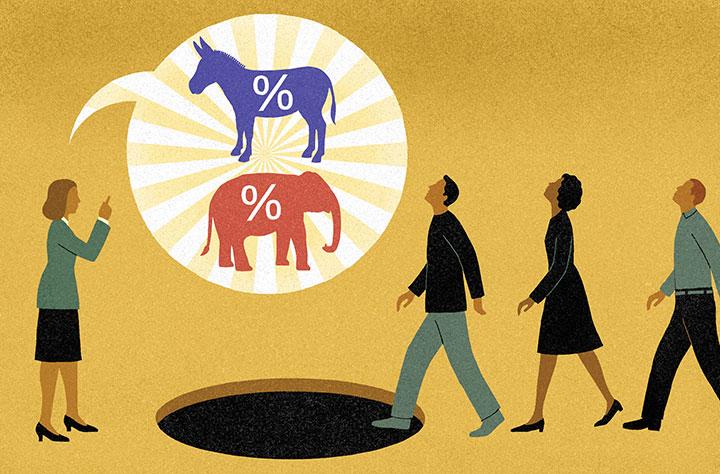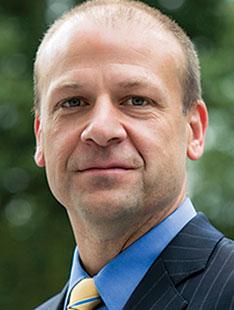Tom Bevan ’91 is the publisher and co-founder, with John McIntyre ’91, of RealClearPolitics, one of America’s leading websites covering politics and elections.
Almost everyone I met last year had a story to tell about the 2016 presidential election — or, to be more precise, an anecdote that foreshadowed the outcome. Here’s one of mine: I was in Manchester, N.H., in mid-September, and my driver eagerly began asking me questions about the campaign.
He was an affable Muslim immigrant from Pakistan who appeared to be in his 50s. He’d been in America for nearly 30 years, raised his family here, and told a heart-wrenching story about being ostracized by his factory co-workers after Sept. 11 because of his religion. He moved on and started his own company and was now facing anxiety over a recently diagnosed medical condition.
“So who are you going to vote for?” I asked as a courtesy, convinced that I already knew the answer.
“Donald J. Trump,” he responded, to my surprise.
He explained that America is facing what he felt only an outsider with Trump’s business experience could fix. It was a bracing reminder that this election had scrambled most, if not all, political stereotypes and norms.
I heard stories like that everywhere I went. And, unless you live in a hermetically sealed bubble, you probably heard similarly surprising stories from friends, family members, co-workers, or chatty Uber drivers.
So why, despite plenty of signs that something strange was afoot, were so many people shocked by the outcome of the election?
Many were quick to blame the polls, but that’s not quite right. The final RealClearPolitics national poll average — which included 11 surveys conducted during the final five days of the campaign — showed Hillary Clinton with a 3.3 percentage-point lead. She won the national popular vote by 2.1 points — not very different from what the polls predicted.
That’s in line with the RealClearPolitics national poll averages from the 2004 election (off by 0.9 of a percentage point) and the 2008 election (off by 0.3 point) and more accurate than the national polls in 2012, which projected President Obama winning re-election by 0.7 percent. He won by 3.9.
Overall, the state polls weren’t terrible either. The average polling error in the top battleground states (Florida, Ohio, Pennsylvania, North Carolina, New Hampshire, Iowa, Nevada, Colorado, Michigan, Wisconsin, Georgia, Arizona, and Virginia) was virtually identical in 2016 to what it was in 2012, both of which were better than 2008.
True, there were a couple of big surprises, Wisconsin in particular. The final pre-election surveys in the Badger State — including the state’s most respected poll, conducted by Marquette University Law School — all showed Clinton comfortably ahead. She lost the state by less than 1 point. It was a result almost no one saw coming — not even the Trump campaign, which canceled an event planned for the Milwaukee suburbs in the final days of the campaign. (There were no public surveys taken in the final six days of the campaign.)
Trump’s narrow win in Michigan was another surprise, although not as much. Beyond that, however, the final RealClearPolitics averages of other state polls showed tight contests: Clinton held small leads in Pennsylvania and New Hampshire, while Trump clung to similarly small leads in North Carolina, Nevada, and Florida.
Yet heading into Election Day, most Americans were convinced Hillary Clinton would win, and they would not have characterized the race as “close” or “competitive.” And no wonder. Everywhere they looked in the weeks leading up to Election Day there was some “expert” on television, on the internet, on the radio, or in the newspaper declaring with complete confidence that Trump had little or no chance to win the election.
Among the most notable was David Plouffe, the campaign operative who helped engineer Barack Obama’s wins in 2008 and 2012, who proclaimed as early as July and again in late September that Clinton had a “100 percent chance” of winning the election.
Sam Wang, a Princeton neuroscience and molecular biology professor who also runs the Princeton Election Consortium, expressed certitude. He predicted publicly that Trump had a less than a 1 percent chance of winning. After the election, he went on national television and ate a bug as penance.
The Huffington Post election model gave Trump a mere 1.7 percent chance of winning. The New York Times’ model was more generous at 15 percent, and Nate Silver of FiveThirtyEight gave Trump a 28.2 percent chance.
It’s not that Trump wasn’t the underdog. He was. His path to victory in the Electoral College was narrower than Clinton’s, but despite her lead in the national polls, that path was still viable on Election Day. The final RealClearPolitics Electoral College Map showed Clinton winning, 272 to 266, on Nov. 8. All Trump needed to win was to flip a single state. He ended up flipping three.
Looking back, it’s clear what happened: Many pundits and analysts built preconceived theories as to why Trump couldn’t win, and accepted data that supported that conclusion while filtering out any evidence pointing in the other direction. There was also a failure within the media to fully appreciate Trump’s uniqueness as a candidate: his ability to defy political norms and, most importantly, an underestimation of the visceral bond he had formed with key sections of the electorate.
There are plenty of examples, but here’s one that was featured prominently in the campaign coverage: Pundits focused, sometimes obsessively, on how much money Clinton had raised and spent on television ads and the number of field offices she had opened in battleground states. These factors were constantly referred to as a definitive advantage for Clinton, despite the fact Trump had shattered that exact conventional wisdom by mowing down the deepest Republican primary field in history while spending almost no money, with little organization on the ground, and withstanding an onslaught of attack ads — more than $150 million worth — aired against him during the primaries.
Another example was President Obama’s job-approval rating, which was above 50 percent for most of the summer and fall. This was consistently cited as a positive indicator for Clinton. That was one possible interpretation, but not the most logical. A more neutral elucidation was that in a general election pitting the two least liked and least trusted major-party nominees in modern political history, the incumbent president looked better to independent voters with each passing day. This explanation did not necessarily benefit Clinton.
Meanwhile, other important indicators — such as the generic congressional ballot, which surged almost six points in the GOP’s favor in the final few weeks of the campaign — went largely unremarked.
As in many professions, political pundits, journalists, and election analysts often find themselves fighting the last war. In this case, it was the re-election of Barack Obama. In 2012, the president managed to win a second term despite several traditional indicators suggesting he wouldn’t: relatively high unemployment and a stagnant economy, a job-approval rating under 50 percent for most of the campaign, close to two-thirds of the country saying things were headed in the wrong direction, and unease among independent voters.
Perhaps the biggest question of 2016 was whether Obama’s electoral coalition would be durable and transferable to his successor. We now know the answer is no — at least in regard to Hillary Clinton.
Moving forward, the same question applies to Donald Trump, a man who managed to take over the Republican Party and at least partially remake it in his own image in a matter of 18 months. He rallied working-class voters to his cause by bucking four decades of party orthodoxy on trade and explicitly rebuking the GOP establishment on foreign policy.
But is the coalition that elected Trump unique to him? Will it stick with him moving forward? Will the Republican Party really transform into a populist, working-class party that is less interventionist abroad?
Already, apparently unfazed by the mistakes of the past year, some of the same experts who insisted Trump could never win the Republican nomination and would never win the general election are declaring with absolute certainty that he will be a failure as president and a one-termer. That may prove to be true, but so is the possibility that Trump may once again defy expectations of the pundits.
Sixty-eight years ago, the Chicago Daily Tribune blared its infamous headline “Dewey Defeats Truman.” In 2016, much of the public was stunned by the election outcome, not because the polls were more wrong this year than in previous years, but because the pundits were. Here’s hoping we’ve learned our lesson.



